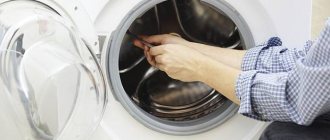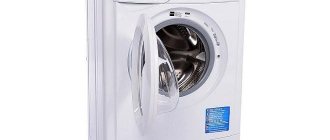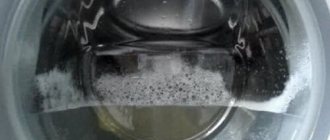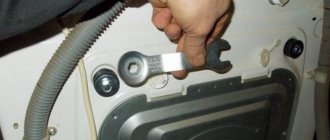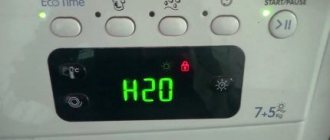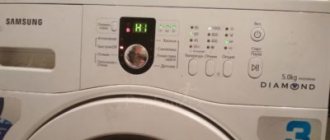Washing machines do not drain water: 5 main reasons
If the washing machine does not drain the water, then the first thing you should do is inspect it for visible damage. The experience of household equipment repair technicians shows that the following customer complaints are often the following: the machine does not drain the water, does not heat the water, the washing machine knocks out the RCD when turned on. In this article we will talk about why the drain in the washing machine does not work and when the problem can be fixed with your own hands, and when it is better to contact a professional.
The machine does not drain water during operation: reasons
Why did the machine break down and not drain? The reasons may be varied. You can often encounter this situation: the washing machine was functioning properly, but at some stage of the wash it filled the drum with water and stopped. No amount of on/off action, changing the operating mode or pulling the plug out of the socket can make the unit work or at least drain the water so that wet things can be removed.
You can drain the water from the machine through a special hole.
What to do:
- Do not panic;
- Drain the water by hand;
- Use a drain filter.
It is important not to forget to place a basin under the washing machine so that the water that flows from the filter does not flood the neighbors. Then you need to check the filter itself, it is important that the cause of the breakdown is identified. Maybe the machine is clogged, then you need to carefully check whether there is dirt in the filter and in the hole in which it fits, for example, buttons, coins, threads, pins, small items of clothing, etc. All this needs to be removed, and the filter should be washed well with water and installed in its original place, carefully tightening it.
After this, it is possible to check the functioning of an automatic or semi-automatic washing machine by running it in any program, and, if it works well, forget about the problem.
If the filter is not dirty, but the water still stands and does not drain, in this case you should check it and inspect the drain hose. If the hose is connected to the sewer, it is quite possible that the blockage is located at the point of its connection (usually mounted to the siphon) or in the pipe itself. It’s not difficult to check if there is a blockage - you need to remove the drain hose from the sewer, hang it over the washbasin, and turn on the washing machine to any program. If during operation water flows freely through the drain hose, then the problem is in the siphon or sewer system, which is clogged.
If the filter and sewage system are clean, but the water still does not drain out, in this case the drain pump (pump) of the washing machine has broken down. The fault lies in the pressure switch (water level sensor) or in the electrical module. If the failure was preceded by carrying or transporting a Beko, Atlant, Samsung, Ariston, Zanussi, Indesit, Bosch or another model of washing machine, then the likelihood of the pressure switch breaking down increases significantly. In any case, you will need to open the washing machine, disconnect the pump, pressure switch or electrical module and find out whether the elements work. It is not recommended to do all this yourself; usually, no one can carry out high-quality repairs with their own hands, but they just manage to break something. If a breakdown occurs, the right thing to do is contact a professional technician.
Pressostat malfunction
If the drain pump is intact and no blockages are found, you need to proceed to checking the water level sensor. To do this, you need to unscrew two screws from the back of the LG washing machine, slide it back and remove the top cover. In the right corner in the front part of the case, near the control panel, there is a round part with a sensor - a pressure switch. It can be removed very easily, you just need to unscrew the fasteners, disconnect the wiring and remove the hose. You will need to check the device for damage, inspect the hose for blockages and cracks, and also perform wiring diagnostics. If everything is in order, you should move on to the next step.
Why doesn't the drain in the washing machine work?
So, the reason that the drain in the washing machine does not function may be an incorrectly selected washing mode. Experts advise rechecking the selected programs if the washing machine’s behavior seems to be faulty.
The drain in the washing machine may not work if the contacts are burnt out.
The program can be confused by accident or it can be knocked down by children by pressing the “non-drain mode” button for brands such as:
- Samsung;
- Indesit;
- Eyelid;
- Ardo;
- Candy;
- Ariston;
- Bosch.
When the pipe inside the washer, which goes from the drum to the pump, is clogged, you can find swimming trunks or other small things there, and as a result, the washer does not drain water well and makes a humming sound when operating. Problems with electrical wiring are common. The machine may malfunction due to a violation of the integrity of the electrical wiring inside the machine. An experienced technician will identify this problem very easily. The failure of the control module (programmer) initiates a problem in the firmware, or burnt-out circuits make the module faulty and, as a result, the washing machine does not drain water.
Here, either repairing the electrical module or replacing it completely with a new one will help.
There are many reasons why the washing machine has stopped draining water, and it is unrealistic to insure against all problems 100% even with high-quality care of the unit. The key to a complete repair in this case is an accurate diagnosis.
Spin problems
The lack of spin or its poor quality in LG washing machines may be due to the following malfunctions:
- Mode failure. In this case, the LG washing machine may reduce the spin speed, resulting in clothes remaining wet. To solve the problem, you should restart the program.
- Motor malfunction. If this unit is damaged, spinning will not take place. To carry out repairs, you need to check the winding and brushes.
- The tachometer is broken. The washing machine does not reach the required speed and does not provide high-quality spinning of the laundry. Usually the problem is caused by the mounting screw and needs to be replaced or unscrewed and screwed in again.
- Spin problems may be caused by a faulty or clogged drain system. You need to check the pump, drain hose and filter.
First aid when the washing machine does not drain water and is humming
Repair experts advise you to take simple steps to provide first aid. Unplug the washing machine from the outlet. A container with low sides should be placed under the drum near the loading door. In the same area there is a pump filter that needs to be twisted and cleaned if necessary. If after removing the filter it is not possible to drain, then the reason is in the pipe. It's not easy to remove. If you don’t have confidence in your abilities, then it’s better to call a specialist.
If you are determined to figure it out without a professional, you need to sort it out like this:
- Unscrew the screw fasteners of the drain assembly and remove it;
- Remove the clamp securing the pipe to the volute;
- Place the end part of the pipe in a container to drain the water;
- Inspect the corrugation for large blockages;
- Return the washer to its original state.
If you do not have experience repairing washing machines, it is recommended to call specialists
It is also necessary to check the rotation of the impeller of the pumping element. This part can be found behind the filter. It may be time to change your pump. In order to understand this, you should remove the filter, turn on the push-up mode, and shine a flashlight into the hole for the filter. If the impeller is clean, but does not rotate, then this is a sure sign that the pump needs to be replaced.
It is imperative to check the correct assembly yourself. Then you need to turn on the washing machine, and then check all fasteners and connections again.
The best solution, of course, would be to call a specialist who can easily determine the reason why the machine does not pump out water and eliminate it. Self-confidence can cause irreversible consequences. A simple cost calculation will convince the housewife that calling a professional will cost several times less than purchasing a new washing machine.
How to quickly drain water
To diagnose a breakdown yourself, you first need to drain the water from the drum.
Here are four ways to do this:
- Through the drain hose. This method comes to mind first. The main thing here is to make sure that the sleeve lies below the level of the tank. In this case, the water will flow by gravity. Next, place a bucket or any other container under the tube and wait until the liquid comes out.
- Through the drain filter. Here you will need low containers, because the filter is located almost to the floor. Place a container under the filter hatch and carefully unscrew the cap. There is no need to do this completely. It is enough to wait for the moment when the water flows.
- Emergency hose. Some equipment manufacturers (not all of them) introduce a special emergency hose into their devices, just for cases when you need to urgently drain the water in the tank. It is located under the plug, in the same place as the filter. Take out the tube, lower it into the prepared container and remove the plug.
- Drain pipe. You should resort to this method only when the previous methods did not work. Open the back panel of the machine and find the drain pipe. Most often it is under the drum. Throw rags on the floor and place a container under the pipe. Remove the clamp and carefully begin to disconnect the pipe itself. Be prepared for a lot of water to flow out of the tank.
What to do if the washing machine does not drain water
The symptoms that should alert the housewife or owner are obvious - the water suddenly began to drain very badly, the washing program following the previous one starts problematically, the washing machine does not pump out water at all.
If the washing machine does not drain water, then the display may show an error, thanks to which you can determine the cause
The following problems are popular:
- The water is drained in alternations (that is, not every wash is completely drained).
- The washing mode is accompanied by draining, but the rinsing mode is not.
- The laundry spinning mode is completely blocked.
Noises during draining or malfunction of the washing machine are an alarm signal, so you should contact a specialist or, as already noted, conduct an independent inspection of the washing machine.
Prevention recommendations
The lion's share of problems can be easily avoided by following simple recommendations for operating washing machines:
- Before washing, check your clothing pockets to ensure there is nothing in them. You even need to get store receipts. Do not allow the grinding and crackling of foreign objects to come from the drum.
- Do not fill the drum with clothes to capacity. It is better to wash clothes twice;
- It is better to wash bras in a special bag - a flying bone can damage the impeller;
- Do not pour too much powder into the tray, as it may become clogged. Lumps of powder settle on the walls of the pipe, and the drain hole narrows because of this. The problem may cause water to begin to accumulate in the air conditioner compartment.
- Buy a surge protector and connect the device through it. This will help prevent the consequences of voltage surges;
- Occasionally clean the machine parts to remove hair, foreign objects and debris. This can also help in cases where the machine is making a lot of noise.
A modern washing machine does not drain water well: malfunctions
If the washing machine does not drain the water and spin the washed clothes after all the cleaning you have done yourself, you need to take action. In any modern washing machine, the drain plays a vital role. With its help, the water in the drum is changed, which is necessary when alternating work programs - for example, from washing to rinsing.
In order for the washing machine to drain water well, it must be connected strictly according to the instructions.
In addition to a faulty drain, the housewife may encounter the following problems:
- The machine does not heat the water. This means that the water heater (heating element) has most likely burned out.
- The washing machine does not start. Most likely, the start button is broken or the hatch is not closed. The socket may be faulty.
- Strange noises appeared. A foreign object may have entered the drum.
- Noises and vibrations are noticeable. This means that the bearings need to be replaced.
- Knocks out traffic jams. The cause may be a burnt-out heating element or a weak installed circuit breaker.
- The washing machine leaked. The seal of the tank or hose is broken.
- The drum does not rotate. The drive belt may be broken or the control system may be faulty.
- If there is an electric shock, it means there is no grounding on the machine.
Other reasons
The washing machine stops draining water not only due to internal breakdowns. The problem may occur due to a clog in the sewer pipe. It can be eliminated using special chemicals or, if the problem is serious, with a cleaning cable.
In addition, if you connect the machine directly to the sewer pipe, the problem may be in the height of the bend of the hose - the distance between the bottom point of the tube and the top. This is necessary so that the water does not leave the machine by gravity during washing. It is recommended to install the drain hose so that the bend is 60-90 cm from the floor. If this distance is greater, the pump may not be able to pump out water.
When connecting the hose directly to the sewer, do not forget about the drain seal - a special rubber band that will allow you to connect tubes of different diameters.
Expert advice
The washing machine will work reliably, washing your clothes efficiently with repeated changes of water, if you follow simple rules and follow the advice of an expert professional.
To ensure that your washing machine performs the water spinning function, do not forget to do the following:
- Preparing items for washing;
- Preliminary inspection of clothing items and emptying pockets of their contents will prevent the filter from clogging.
Cleaning the filter
Systematic cleaning of the filter and freeing it from small parts will allow the machine to drain water without failure.
Call the master
If you can’t diagnose LG SMA yourself, you can always call a specialist for repairs. It is advisable to contact companies that have been on the market for providing services for several months and have a decent reputation.
It is not difficult to find such a company on the Internet by additionally entering the name of your city in the search. You can contact the company by phone listed on the website or by leaving your contact information for the manager to contact. After eliminating the malfunction, the master gives a guarantee for the work performed.
The average cost of services in Moscow is:
- repair of damaged wiring – from 2,000 rubles;
- repair of the control module – from 2,600 rubles;
- replacement of the drain pump – from 2,100 rubles;
- blockage in the drainage tract - about 1,500 rubles.
The cost of work may vary by region and even vary widely within the same city.
Restoring the car yourself
In order for the result of the troubleshooting work to be positive and the machine to begin draining at the end of the selected operating mode, a “diagnosis” must be correctly made. Then eliminating the cause with your own hands will be easier and faster.
If the reason is not completely clear, then you can independently check each system of the device and carry out preventive maintenance. In any case, the machine will work better, and the cause of its breakdown will be promptly found and eliminated.
Cleaning the filter
Since the filter is designed to collect debris in the system, inspection of the machine to identify the cause of the malfunction should begin with it.
This filter is located on the front of the machine in its lower half and has a hidden door. The door closes with internal latches, which open when you lightly press the door surface.
In some washing machine models, the filter door is opened using a regular screwdriver. It should be remembered that the process of removing the filter is usually accompanied by the appearance of accumulated liquid. Therefore, prepare rags in advance; a container for collecting them will also come in handy.
Now you should remove the filter and inspect it. The filter should be removed by twisting it counterclockwise. When significant difficulties arise, use pliers.
Now you can see what the condition of the filter is. If there is debris, objects, hair or animal hair inside the grill, it should be cleaned.
Now the filter is installed back.
The filter cleaning process should be carried out regularly and be included in the maintenance of all brands of washing machines.
Cleaning the filter once a week will prevent disturbances in the functioning of the unit and will maintain the high functionality of the machine. Simple steps to restore the filter can be easily done with your own hands.
Blockage in the pipe
The hose passing from the tank to the pump is the pipe. When a plug of debris appears inside the pipe, its permeability decreases, water does not drain, and the drain and spin function does not work. An object located in the hole intended for draining is capable of preventing water from passing through. Then you will need to remove it.
To provide access to the pipe, you will need to unscrew the bolts on the back of the machine that hold it in place. Using pliers, the clamps are removed and the hose can be removed. Now we clean the pipe.
You can find out whether there is debris in it by carefully palpating it. The presence of a dense plug inside is an indicator that there is debris inside and will need to be removed.
The drain hose is cleaned with water pressure or with a regular rag or brush. Next, the cleaned hose of the pipe is mounted in its original place. Particular attention must be paid to the clamps: they must clamp the hose as tightly as possible to eliminate the risk of leaks during operation of the machine.
Checking the condition of the impeller
The machine also stops spinning due to malfunctions in the functioning of the impeller.
The quality of its work should be checked by analyzing the process of jamming the part.
When performance deteriorates, there is weak or untimely jamming or free-running.
Normal operation of the impeller is characterized by jerky rotation. It is difficult to identify a malfunction of the impeller without examining its condition: when the spin mode is turned on, the machine hums characteristically, but the water remains in the drum and the laundry is not wrung out. The load on the engine is observed, but there is no result.
The part is located behind the filter, which is the first to be cleaned when there is a drain malfunction; access to it is also on the front surface of the device.
You can first detect a foreign object (for example, there may be a coin or a match there) by checking with your fingers: sometimes the interfering object can be seen visually. Then they just take him out.
If, after removing a foreign object from the impeller (or during normal operation), the machine does not function properly, you will need to examine the operation of the pump.
Pump or pump: looking for a malfunction
It is recommended to diagnose pump failure after analyzing the condition of the filter and sequentially checking the impeller.
When they are in good working order and thoroughly cleaned, but the machine continues to “refuse” to spin and drain water, you will need to carry out the following actions:
- take out the filter;
- make sure the impeller is in good condition;
- provide lighting when installing the filter. A flashlight may be needed here;
- install the “Drain” program and check: the impeller remains motionless - which means the problem lies in the pump.
Another method of checking the functionality of the pump is to use a tester, or multimeter. With such a device you can ring the motor winding of the unit, which often burns out in the event of excessive load, which occurs when the impeller jams.
The best solution is to purchase and install a new motor winding or pump. Repairs are often half the cost of a new item.
Pumps in household appliance stores are offered in a wide range at affordable prices. You can choose it depending on the version of the car; the most popular and modern manufacturers are Indesit , Bosch , Ariston , Samsung and others.
Pump replacement procedure
Self-replacement of the pump is carried out according to a certain algorithm. The sequence of actions is as follows:
- The washing machine is completely drained of water.
- Place the machine on its side: this will make it easier to do work.
- The entire drain assembly is removed.
- The screws that hold the pump are unscrewed; there are three of them.
- The contacts are disconnected, and here you need to be extremely careful. Each contact can be marked for further assembly.
- Now the new part is mounted on the vacated space intended for it, and the contacts are connected. And here the mark made at the disassembly stage will help.
- Next, the machine is completely assembled.
After installing a new pump, it is necessary to check the quality of its functioning.
Electrical wiring faults
If all the above measures have been taken, and the washing machine still does not drain the water. You'll have to check the electrical wiring.
The following situations can cause damage to it:
- The contacts have come loose from the pump. You just need to secure them more firmly.
- A short circuit caused by contact of exposed wires.
- The microcircuit burned out, and the result was no signal to the pump.
All wiring work must be carried out without voltage to ensure safety. To obtain a guaranteed positive result, it is recommended to entrust the electrical wiring inspection to specialists.
Pressostat malfunctions
The operating principle of the water level sensor is as follows. In the process of collecting liquid, pressure increases, transmitted through a rubber tube going to the sensor.
When a certain amount of water is collected, the sensor reacts by stopping by transmitting a signal: it goes to the control board.
If the pressure switch malfunctions, the sensor sends an “incorrect”, simulated signal: the liquid is drained, the machine does not spin.
To diagnose the pressure switch, you will need to find access to it; the sensor is located behind the back cover of the machine. The cover is removed after unscrewing the bolts holding it in place.
Having seen the sensor, you should blow into the tube: when it is functioning normally, the pressure switch snaps off. Failure to click indicates that the device is broken.
The programmer is broken
The most advanced and thoughtful models of washing machines from manufacturers Bosch, Indesit, Ariston have immediately installed boards called modules.
Such a board can be called the real “brain” of the machine; data on program management is recorded on it; the board regulates water drainage and spinning.
Each part of the board is carefully processed in a special way, which protects it from corrosion and the negative effects of moisture. However, some of the smallest parts of the microcircuit may fail.
It is difficult to diagnose such a malfunction on your own; you can first assume its breakdown after a thorough check of the simpler breakdowns mentioned above.
Repairing the programmer is not easy and requires the participation of a specialist.
How to recognize an error
Not all El G washing machines are equipped with a display. Models with electromechanical control display the error code in their own way:
- All Rinse modes indicate the OE error by flashing or staying lit.
- The “Spin” mode at 800 and 500 blinks (lit) along with No Spin (800-500 rpm, also “No spin”).
What does error 0E mean in an LG washing machine: problem with water drainage. The system signals the drain pump to remove water from the tank. If he fails to do this within 5 minutes and the machine is still filled with water, the operation stops and an error is displayed.
